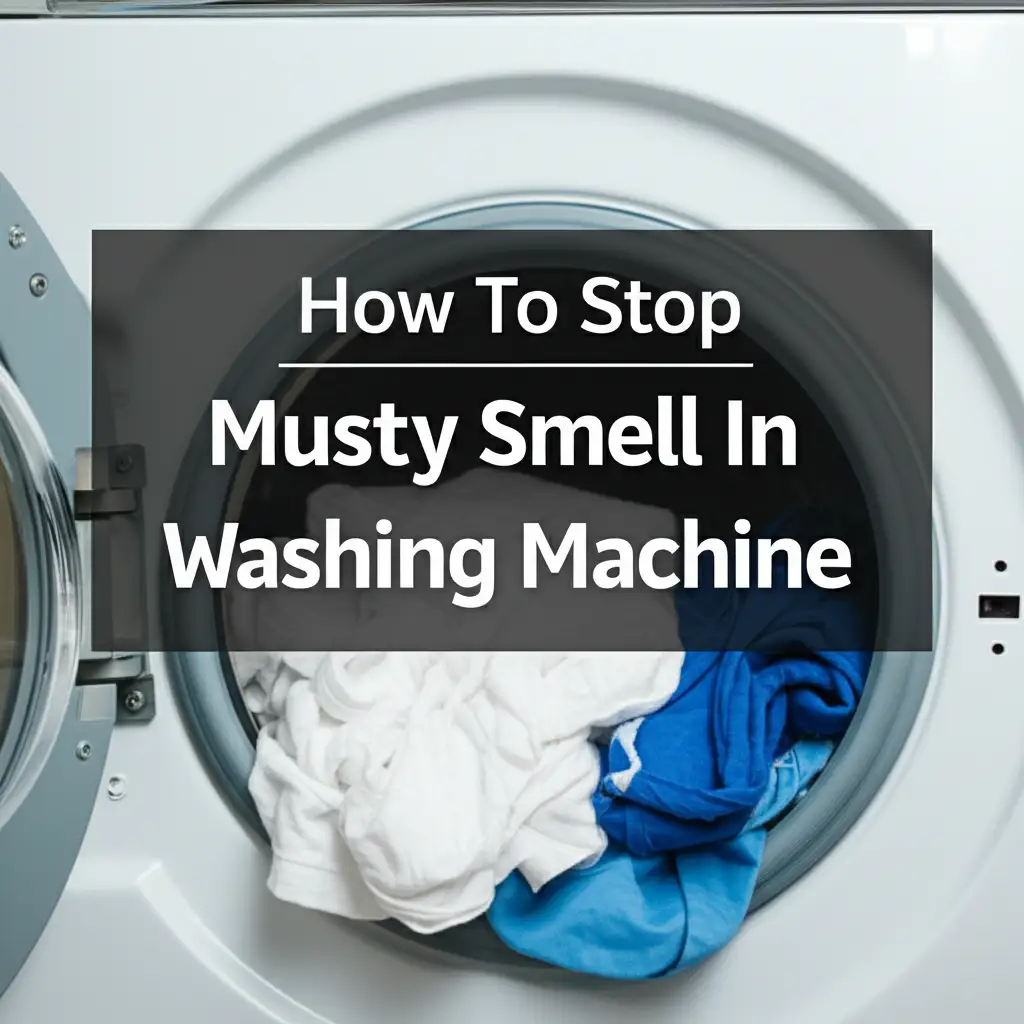· Tessa Winslow · Home Care · 16 min read
How To Stop Musty Smell In Washing Machine

Stop Musty Smell in Your Washing Machine: A Fresh Guide
Have you ever opened your washing machine door only to be hit by a truly unpleasant musty smell? It is a common problem, and it can make your clean clothes feel less than fresh. That musty odor often signals the presence of mold or mildew growing inside your appliance. This happens because water, detergent residue, and warmth create a perfect breeding ground for these unwanted guests.
A smelly washing machine is not just annoying; it can also affect the cleanliness and scent of your laundry. Thankfully, stopping a musty smell in your washing machine is possible with the right cleaning techniques and consistent maintenance. I will guide you through understanding why this smell occurs, how to deep clean your machine, and what daily habits prevent its return. By the end, your laundry room will smell clean again, and your clothes will feel truly fresh.
Takeaway
- Regularly clean your washing machine with vinegar or bleach to kill mold and mildew.
- Always leave the washing machine door ajar after use to allow air circulation.
- Use the correct amount of high-efficiency (HE) detergent and avoid overloading the machine.
- Clean the detergent dispenser, gasket, and filter often.
- Run monthly cleaning cycles to prevent odor buildup.
How do I stop a musty smell in my washing machine?
To stop a musty smell in your washing machine, regularly clean it by running a hot water cycle with two cups of white vinegar or a quarter cup of bleach. Always leave the door open after each wash to dry the interior and prevent moisture buildup, which causes mold and mildew. Also, clean the detergent dispenser and rubber gasket frequently.
Understanding the Musty Smell: Why Your Washer Stinks
A musty smell in your washing machine indicates more than just an old appliance. It often points to the growth of mold or mildew. These fungi thrive in damp, dark environments. Your washing machine, with its consistent exposure to water and leftover detergent, offers the perfect conditions for them to multiply.
Many factors contribute to this unpleasant odor. Residual water often gets trapped in crevices or the detergent dispenser. This standing water provides the moisture mold needs to grow. Detergent and fabric softener residues also play a role. They can build up inside the drum, hoses, and dispenser. This residue acts as food for mold and mildew, making the problem worse. Using too much detergent also adds to this buildup. When you use excess product, it does not fully rinse away, clinging to the machine’s parts. This creates a sticky film that traps moisture and dirt.
Modern high-efficiency (HE) washing machines use less water, which can sometimes worsen the issue. While energy-efficient, they may not rinse away all soap residue as effectively as older models. This leads to more buildup over time. Cold water washing also contributes to the problem. While great for energy saving, cold water does not dissolve detergent as well as hot water. It also fails to kill mold spores, allowing them to persist and grow. Overloading your machine is another common culprit. When the washer is too full, water and detergent cannot circulate properly. This means clothes do not get a thorough rinse, and more residue is left behind in the machine. Understanding these causes helps us tackle the problem effectively.
Gathering Your Tools: What You Need for a Deep Clean
Before you begin cleaning your washing machine, collect all the necessary supplies. Having everything ready makes the process smoother and more efficient. You likely have most of these items already in your home. These tools help you remove the grime and mildew causing the unpleasant musty smell.
You will need white vinegar, which is a powerful natural disinfectant and deodorizer. Its acidic nature helps break down mineral deposits and soap scum. Baking soda is another essential item. It is a natural abrasive and odor absorber. Together, vinegar and baking soda create a powerful cleaning solution that tackles tough odors. For scrubbing, gather a few clean cloths or microfiber towels. These are useful for wiping down surfaces and reaching into tight spots. An old toothbrush or small brush is also handy for cleaning hard-to-reach areas like the detergent dispenser or rubber gasket. You might also want a spray bottle to mix and apply cleaning solutions.
For a more intense cleaning, especially if you have significant mold buildup, consider using bleach. However, be cautious when using bleach; never mix it with vinegar, as this creates dangerous chlorine gas. Always use protective gloves to shield your hands from cleaning agents. Finally, a bucket or small basin can be useful for holding water or removing parts for cleaning. Having these items on hand ensures you are prepared to give your washing machine a thorough cleaning. This preparation is a crucial step in eliminating that musty smell and restoring freshness to your laundry appliance. Knowing what to add to a washing machine for cleaning can make a big difference.
Deep Cleaning Your Washing Machine: Step-by-Step for Front-Loaders
Front-load washing machines are known for their efficiency, but they are also notorious for developing musty smells. This often happens because water gets trapped in the rubber gasket around the door. Regularly cleaning your front-loader is key to preventing these odors. I will guide you through a thorough cleaning process.
First, you will deep clean the drum. Start by adding two cups of white distilled vinegar to the detergent dispenser or directly into the drum. Set your washing machine to the hottest water setting and the largest load capacity. Run a complete wash cycle without any laundry. The hot water and vinegar will work together to dissolve soap scum, kill mold, and neutralize odors. If your machine has a “self-clean” or “washer clean” cycle, use that setting. After the cycle finishes, wipe down the inside of the drum with a clean cloth to remove any loosened residue.
Next, focus on the rubber gasket, or boot, around the door. This area traps water, lint, and mold. Pull back the folds of the gasket carefully. You will likely find black mold or mildew buildup here. Dip a clean cloth in a solution of equal parts white vinegar and water. Wipe down the entire gasket, paying close attention to every crease and fold. For stubborn mold spots, you can use an old toothbrush dipped in the vinegar solution to scrub gently. Some people use a bleach solution (1 part bleach to 4 parts water) for very severe mold, but always rinse thoroughly afterward and never mix bleach with vinegar. After scrubbing, wipe the gasket dry with a clean towel. Drying this area completely after each wash cycle is a great preventative measure. This step is vital for stopping musty smell in washing machine units. For more general advice, you can learn about doing it yourself with your washing machine.
Tackling Top-Loaders: Deep Cleaning Your Top-Load Washing Machine
Top-load washing machines, while different in design from front-loaders, can also develop a musty smell. This often occurs due to detergent residue buildup, hard water deposits, and the accumulation of mold or mildew within the drum and other components. Cleaning a top-loader requires a slightly different approach, but it is just as effective at eliminating odors.
To start, fill your top-load washer with the hottest water setting on the largest load size. Add four cups of white distilled vinegar directly into the drum. Let the machine agitate for a few minutes to mix the vinegar thoroughly with the water. Then, pause the cycle and let the vinegar water sit in the machine for at least an hour. This soaking period allows the vinegar to break down soap scum, kill bacteria, and loosen any mold or mildew. After the soak, restart the cycle and let it complete. Once the cycle finishes, wipe down the inside of the drum with a clean cloth to remove any lingering residue.
After cleaning the drum, turn your attention to other areas. Clean the detergent and fabric softener dispensers. These compartments can accumulate sticky residue. Remove them if possible and wash them thoroughly with hot, soapy water and a small brush. Rinse them well and replace them. If they are not removable, use a damp cloth and a brush to scrub inside. Also, lift the agitator if your model allows and clean underneath it, as this can be a hidden spot for mold. For specific instructions on cleaning this part, check out our guide on how to clean a washing machine agitator. Finally, run a second cycle on the hottest setting, this time adding half a cup of baking soda to the drum. Baking soda acts as an abrasive to remove any remaining gunk and helps deodorize the machine. Once this cycle is done, your top-loader should smell much fresher, free from the musty odor.
Cleaning Specific Components: Dispenser, Gasket, and Filter
While deep cleaning the drum is crucial, neglecting specific components can leave you battling the musty smell in your washing machine repeatedly. The detergent dispenser, rubber gasket (especially on front-loaders), and drain filter are prime spots for mold, mildew, and residue buildup. Cleaning these areas thoroughly is essential for a truly fresh machine.
The detergent dispenser often becomes a sticky mess of old soap and fabric softener. This residue traps moisture and becomes a breeding ground for mold. If your dispenser is removable, take it out. Wash it under hot water with a brush or old toothbrush to scrub away all the gunk. You might need to soak it in hot, soapy water or a vinegar solution to loosen stubborn buildup. Rinse it thoroughly and dry it before putting it back. If your dispenser is not removable, use a damp cloth and a brush to clean inside all the compartments. Pay attention to the corners and crevices. Understanding what goes where in a washing machine can help you locate all these compartments.
The rubber gasket on front-load washers is a well-known culprit for musty smells. This flexible seal around the door traps water, lint, and pet hair, creating a perfect environment for mold. Regularly pull back the folds of the gasket. Use a spray bottle filled with equal parts white vinegar and water, or a specialized washing machine cleaner, to spray the entire area. Let it sit for a few minutes, then wipe it down with a clean cloth. For stubborn black mold, use an old toothbrush to scrub gently. Always dry the gasket completely after each use of the machine to prevent future growth.
Finally, do not forget the drain pump filter, sometimes called the coin trap. This filter catches small items like coins, buttons, and lint, preventing them from clogging the drain pump. However, it can also accumulate grime and stagnant water, leading to a foul odor. Locate your machine’s drain filter (usually at the bottom front of front-loaders or sometimes behind a panel). Place a shallow pan or towel underneath to catch any water. Carefully unscrew or unlatch the filter. Remove any debris, clean the filter under running water, and wipe out the housing. If you find your washing machine is blocked or not draining, this filter is often the first place to check. Reassemble everything securely. Cleaning these parts regularly will significantly reduce the chances of a musty smell returning.
Everyday Habits: Simple Ways to Prevent Musty Smells
Once you have deep cleaned your washing machine, adopting simple daily habits is crucial to keep the musty smell from returning. Prevention is always easier than a cure. These practices aim to reduce moisture and detergent residue, which are the main culprits behind unwanted odors. Making these small changes will ensure your washing machine stays fresh long-term.
First, always leave the washing machine door ajar after each load. This allows air to circulate inside the drum, helping it to dry out completely. A closed, damp environment is precisely what mold and mildew need to thrive. For front-loaders, pulling back the rubber gasket slightly also helps air reach hidden damp spots. This simple action is one of the most effective ways to prevent moisture buildup. If you have children or pets, ensure the door is securely latched when not in use for safety, then open it again when possible.
Next, pay attention to your detergent use. Using too much detergent is a common mistake. Excess detergent creates more suds and residue that can cling to the inside of your machine. Always follow the manufacturer’s recommendations for detergent quantity, especially if you have a high-efficiency (HE) machine. HE detergents are concentrated and produce fewer suds. Using the right amount prevents buildup and ensures a proper rinse. You can also consider using a liquid detergent over powder, as powder can sometimes leave more residue. Running regular maintenance cycles is also a smart habit. Once a month, run an empty hot water cycle with two cups of white vinegar or a washer cleaning tablet. This helps flush out any lingering grime and keeps the machine fresh. For specific models, like an LG HE washing machine, follow the manufacturer’s cleaning recommendations to properly maintain your unit and clean an LG HE washing machine.
Finally, avoid leaving wet clothes in the washing machine for extended periods. As soon as a wash cycle finishes, transfer your laundry to the dryer or hang it to dry. Wet clothes sitting in a damp machine exacerbate the growth of mildew, not only in the machine but also on your clothes. Promptly removing laundry ensures the machine can begin to dry out. Also, wipe down the detergent dispenser and the rim of the drum after each use if you notice any wetness or residue. By consistently following these simple habits, you will significantly reduce the chances of a musty smell taking hold in your washing machine again, keeping it clean and ready for your next load.
Advanced Solutions and When to Seek Help
While regular cleaning and good habits prevent most musty smells, sometimes the odor persists. This might indicate a deeper issue that requires more advanced solutions or even professional help. Do not get discouraged if the smell lingers after basic cleaning; there are still steps you can take.
One advanced solution involves using specialized washing machine cleaning products. These products, often in tablet form, are designed to deep clean and sanitize the internal components of your machine. They target hidden areas that might be difficult to reach with manual scrubbing. Follow the product instructions carefully, usually involving running a hot, empty cycle with the tablet. These cleaners can be more effective at breaking down stubborn biofilm and mineral deposits that vinegar and baking soda might miss. Some also contain anti-fungal agents to kill resilient mold spores. Another consideration is the water quality in your home. Hard water, rich in minerals, can contribute to residue buildup inside your washing machine. Installing a water softener can reduce mineral deposits, making it harder for mold and mildew to adhere to surfaces. This is a larger investment but can benefit your washing machine and other appliances.
If the musty smell persists despite consistent cleaning and advanced products, it might be time to investigate potential mechanical issues. A partially clogged drain hose or pump can cause water to back up or drain slowly, leaving standing water that encourages mold growth. Check the drain hose for kinks or blockages. You might need to disconnect it and clear any obstructions. A professional appliance technician can properly diagnose and fix issues like a faulty drain pump or severely clogged lines. They have the tools and expertise to reach internal components you cannot access safely. If you have done everything possible to stop musty smell in washing machine units and it still stinks, professional intervention is a wise next step. Ignoring persistent odors could lead to larger problems or even damage to your appliance over time.
FAQ Section
Q1: Why does my washing machine smell musty even after cleaning?
A musty smell can return if the machine does not dry properly between uses. Mold and mildew thrive in damp, dark environments. Ensure you leave the door ajar after each wash. Also, check the rubber gasket and detergent dispenser for hidden residue buildup. You might need a more thorough deep clean, including the drain filter, or consider a professional cleaning solution if the problem persists.
Q2: Can I use bleach to clean my washing machine?
Yes, you can use bleach to clean your washing machine, especially for tough mold and mildew. Add a quarter cup of bleach to the dispenser and run a hot, empty cycle. Never mix bleach with vinegar, as this creates dangerous chlorine gas. Always rinse the machine thoroughly afterward to avoid damaging clothes in future washes.
Q3: How often should I clean my washing machine to prevent smells?
You should deep clean your washing machine at least once a month. For high-use households or those with hard water, cleaning every two to three weeks might be beneficial. Regular wiping down of the door seal and dispenser after each use, along with leaving the door open, also helps prevent daily buildup.
Q4: Does using too much detergent cause musty smells?
Yes, using too much detergent is a common cause of musty smells. Excess detergent creates suds and residue that do not fully rinse away. This residue builds up in the drum and hoses, acting as food for mold and mildew. Always use the recommended amount of detergent, especially high-efficiency (HE) formulas.
Q5: What is the best natural cleaner for a smelly washing machine?
White distilled vinegar and baking soda are excellent natural cleaners. Run an empty hot water cycle with two cups of vinegar to kill mold and dissolve soap scum. Follow up with another hot cycle using half a cup of baking soda to further deodorize and scrub away residue. These are safe and effective options.
Q6: How do I clean the rubber seal (gasket) on my front-load washer?
To clean the rubber seal on your front-load washer, pull back its folds to expose any grime. Spray the area with a mixture of equal parts white vinegar and water, or a dilute bleach solution. Scrub with a cloth or old toothbrush to remove mold and mildew. After cleaning, wipe the gasket dry completely.
Conclusion
A musty smell in your washing machine is a clear sign that moisture, detergent residue, and warmth are creating a breeding ground for mold and mildew. Tackling this issue effectively means combining thorough cleaning with smart preventative habits. I have walked you through everything you need to know, from understanding the causes to performing deep cleans for both front-load and top-load machines. You now have the tools and knowledge to clean critical components like the dispenser, gasket, and filter, which often hide the most stubborn grime.
Remember, preventing the return of that unpleasant musty smell in washing machine units is just as important as the initial clean. Simple actions like leaving the door ajar, using the correct amount of detergent, and promptly removing laundry make a significant difference. Regular maintenance cycles will also keep your machine fresh and efficient. Do not let a smelly washer ruin your clean clothes or your home’s freshness. Take action today using these tips to enjoy a truly clean and odor-free washing machine. Your laundry, and your nose, will thank you for it!





